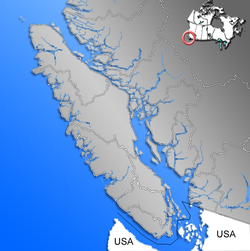Parksville, British Columbia
| Parksville | |
|---|---|
| City | |
| City of Parksville | |
| Nickname(s): Jewel of Vancouver Island | |
| Location of Parksville within the Nanaimo Regional District in British Columbia, Canada | |
| Coordinates: 49°18′54″N 124°18′43″W / 49.315°N 124.312°W | |
| Country | Canada |
| Province | British Columbia |
| Regional District | Nanaimo |
| Incorporated | June 19, 1945 |
| Town status | April 1, 1978 |
| City status | February 15, 1986 |
| Electoral Districts Federal |
Courtenay—Alberni |
| Provincial | Parksville-Qualicum |
| Area | |
| • City | 14.44 km2 (5.58 sq mi) |
| Population (2011) | |
| • City | 11,977 |
| • Density | 830/km2 (2,100/sq mi) |
| • Metro | 27,822 |
| Time zone | PST |
| Postal code | V9P 2H3 |
| Area code(s) | 250, 778 |
| Website | parksville |
Parksville is a city on Vancouver Island, in British Columbia, Canada. The city is on Highway 19A, 37 kilometres north-west of Nanaimo, 48 kilometres east of Port Alberni and 7 kilometres south-east of Qualicum Beach, between Englishman River and French Creek. At the 2011 census, Parksville's population is 11,977 and it is the 15th-largest municipality on Vancouver Island in terms of population.
Parksville is best known for its large sandy beaches at Parksville Bay and Craig Bay. The city's best-known annual event, since 1982, is a sandcastle-building competition in the summer, dubbed "Parksville Beachfest". Beachfest is a World Championship Sand Sculpting official qualification event.
Local media, businesses, and civil services frequently refer to Parksville, with its adjacent municipalities, as the community of "Oceanside", typically including Qualicum Beach, French Creek, Coombs/Hilliers, Errington and Nanoose.
The Spanish were the first Europeans to explore the area in 1791. In Spanish maps, the Englishman River is called "Rio de Grullas," (River of Cranes, i.e. herons) while French Creek is named "Punta de Leonardo."
The first European settler in the Parksville area was John Hirst, who pre-empted 120 hectares (300 acres) of land on both sides of the Englishman River in 1873. The River, as it was known, remained an outpost until the turn of the century when a road was built from Nanaimo.
A post office soon followed in 1877, with mail distributed from the cabin of Nelson Parks (to which Parksville owes its namesake).
At that time, logging was a major industry and the extension of the Esquimalt and Nanaimo (E & N) Railway in 1901, to McBride Junction spurred Parksville’s growth and the beginning of a tourism boom, mainly Vancouver Islanders who travelled to Parksville to enjoy the incredible beaches.
Motels, stores, resorts and campgrounds soon followed and the community continues to prosper today. The Village of Parksville was incorporated June 19, 1945. Parksville became a town on April 1, 1978, and a city on February 15, 1986.
...
Wikipedia

